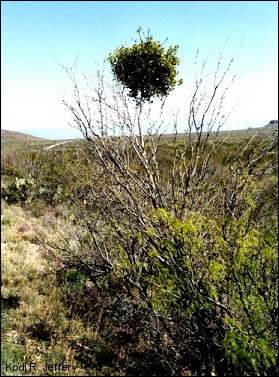
Christmas time—when people may lure others underneath a sprig of mistletoe, hoping for a furtive kiss. This tradition may seem odd, when one realizes that mistletoe is actually a parasite, potentially sickening or killing trees. Its dense foliage creates a tightly woven mass on tree branches, where it can suck the life-juices of the plant.
Perhaps, though, this plant has some redeeming qualities. Its berries
are an important food source for various birds, including our striking Phainopeplas.
But the mistletoe's "ingenuity" is more impressive when you realize it
needs feasting birds to reproduce. Phainopeplas and other birds don't destroy the
seeds in their guts. Later, as the birds relax in a nearby tree, they deposit the seeds
in their droppings, providing fertilizer, as well as a new place to grow. Clearly this
is a case where both the bird and the mistletoe profit. And although the Phainopepla
might not seem parasitic, it's certainly an accessory, albeit unknowing, to the
crime.
![]()
Contributor: Kodi R. Jeffery, Centennial Museum, University of Texas at El Paso.
Desert Diary is a joint production of the Centennial Museum and KTEP National Public Radio at the University of Texas at El Paso.

Mistletoe growing on mesquite, Big Bend National Park. Photograph by Kodi R. Jeffery.
Cottonwood with mistletoe and closer view of mistletoe. Click on the thumbnails for full-sized views.
HowStuffWorks on how mistletoe works. Good introduction to mistletoes.
Kissing under the mistletoe.
The Mistletoe Center. A primary source, including over 1300 bibliographic references.